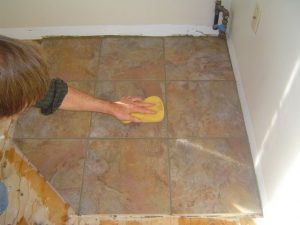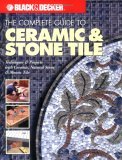Subfloor Deflection Needs to be Nearly Non Existent When Installing a Ceramic Tile Floor
By Mark J. Donovan
|
|
Question: Mark, We had a ceramic tile kitchen floor installed less than a year ago, and now the grout is cracking and some of the tiles are loose. When we had the kitchen remodeled the contractor gutted the kitchen down to the bare floor joists and sistered them with additional lumber to make them level. He then laid down new plywood onto the floor joists. Next he installed Hardibacker cement board on top of the plywood, and finally he installed a layer of mortar on top of the Hardibacker cement board. Any suggestions on how to remedy this problem and why it’s happening will be most appreciated. Thanks! |
Answer: D. G. If the grout is cracking and tiles are loosening up then the subfloor is not rigid enough. Subfloor deflection needs to be nearly non-existent in a ceramic floor tile project.
Though the contractor sistered additional lumber to the floor joists I’d be curious to know how large the floor joists and sistered lumber pieces were. You said he sistered lumber to the old floor joists to level up the floor. However, he should have also used properly sized lumber to stiffen up the floor.
| It is important that the right size floor joists be used for the size of the span. For example for a 12 foot span you need at least a 2×8 and preferably a 2×10. For a 14 foot span you need a 2×10, and preferably a 2×12. Also floor joists should be spaced 16 inches on center, or narrower, if floor tile is to be installed above them. In addition, blocking or bridging is also a good idea for beefing up the floor and preventing flexing.
Also, what type of subfloor sheathing (plywood) did he use? It should have been 3/4 inch tongue and groove plywood with either another 1/2 of plywood (or cement backer board) on top, running orthogonal to it. |
 |
For an inexpensive possible solution I would suggest installing blocking between the floor joists if you have access to them from the basement. This will help mitigate some of the side-to-side flexing of the floor joists and also help a bit with the deflection. If you still have grout cracking and loosening tiles then you’ll have no choice but to beef up the floor joists and/or increase the amount of subfloor sheathing. If you don’t want to go that route then you may want to think about ripping up the ceramic tile floor altogether and installing a Linoleum floor instead.
For information on installing a shower pan membrane liner for a ceramic tile shower, see the Shower Pan Membrane Liner Installation Ebook from HomeAdditionPlus.com. The Shower Pan Membrane Liner EBook will quickly teach you the step-by-step process for installing the shower pan membrane liner correctly. It includes instructions on framing the shower stall, pouring the pre-slope and shower base mortar, and installing the shower pan membrane liner.
See HomeAdditionPlus.com’s Ceramic Tile Calculator
See my “How to Tile a Custom Ceramic Tile Shower” Ebook to learn how to tile your own shower: For a detailed set of instructions on tiling a shower floor and walls, including pictures for every step in the process, see my “How to Tile Custom Ceramic Tile Shower Ebook”.
Related Information
Additional Ceramic Tile Resources from Amazon.com
 |
 |
 |
Get Free Bathroom Remodeling Price Quotes with No Obligation!
Fill out our 3-5 minute quick and easy form, and receive a free price quote on a bathroom remodeling project from one of our pre-screened and licensed bathroom remodeling contractors. This process is free and there is no obligation to continue once you receive your bathroom addition price estimate.
